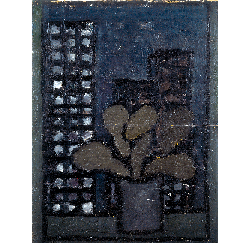-
 Read moreQuick view
Read moreQuick viewLandscape Representations in Palestinian Art and Israeli Art Discourse: The Case of Asim Abu Shaqra
Free!This article will survey the historical shift and ongoing transformation of Israeli discourse on landscape representations in Palestinian art, as illustrated by the case of Asim Abu Shaqra’s (1961-1990) artwork. Abu Shaqra is one of the very few Palestinian artists who have entered the canon of Israeli art. After graduating in 1986 from the Kalisher Art Academy in Tel Aviv, Abu Shaqra had his first solo exhibition in 1988, at Rap Gallery in Tel Aviv. Over the two subsequent years—until his premature death from cancer in 1990, at the age of twenty-nine—he had three more solo shows and participated in four group exhibitions. In 1994, four years after his death, a comprehensive retrospective exhibition of his work was presented at Tel Aviv Museum’s Helena Rubinstein Pavilion.
The art discourse on Abu Shaqra’s oeuvre, from the very beginning of his activity in the 1980s down to this day, reflects the historical transformations that the Israeli artistic field has undergone in relation to the work of Arab-Palestinian artists who graduated from Israeli art schools. Abu Shaqra’s 1994 retrospective exhibition—which took place in the wake of the dramatic period that began with the outbreak of the first Intifada in 1987 and ended with the Oslo Accords in the early 1990s—marked a historical turning point in the discourse on Palestinian art created in Israel. The rise of a public debate over the nature of Palestinian identity, made possible by the peace process and the Oslo Accords, included a process (still unfolding today) of growing recognition of the Palestinian culture created in Israel. This recognition, in turn, has generated a significant shift in the interpretive templates governing the reception of landscape representations in the work of Palestinian graduates of Israeli art schools.Read moreQuick view -
 Read moreQuick view
Read moreQuick viewThe Arab Jew Debates: Media, Culture, Politics, History
For the past twenty-five years, and particularly during the last decade, the idea of the Arab Jew has been debated in multiple forums in different parts of the world. The Arab Jew is represented in literature and film, discussed in blogs and social media, and featured in live performances. It has informed scholarship in literary and cultural studies, sociology, and history, in Israel, the Arab world, Europe, and North America. Yet the term “Arab Jew” remains controversial, especially in Israel, where it is widely viewed as a left-wing political concept. This article surveys the Arab Jew’s full range of expression to date, emphasizing the reciprocal movement of ideas across different geographies and between discursive spheres. It argues that the Arab Jew idea has developed as both a project of political intervention into the present-day separation of Arabness from Jewishness and a project of reconstruction focusing on the Jewish past in the MENA region. Examining recent episodes in the Israeli public sphere, the article investigates how contemporary discussions about Arab Jewish identity and culture utilize competing views of history. It concludes by reconsidering the relevance of the “Arab Jew” to the burgeoning historical scholarship on Jews in the MENA region during the nineteenth and twentieth centuries.
$5.00Free!Read moreQuick view
- Home
- About JLS
- Issues
- Vol. 9 No. 1 | Summer 2019
- Vol 8 No 2 Winter 2018
- Vol. 8, No. 1: Summer 2018
- Vol. 7, No. 2: Winter 2017
- Vol. 7, 1: Summer 2017
- Vol. 6, Summer/Winter 2016
- Vol. 5, No. 2 Winter 2015
- Vol. 5, No. 1 Summer 2015
- Vol. 4, No. 2 Winter 2014
- Vol. 4, No. 1 Summer 2014
- Vol. 3, No. 2 Winter 2013
- Vol. 3, No. 1 Summer 2013
- Vol. 2, No. 2 Winter 2012
- Vol. 2, No. 1 Summer 2012
- Vol. 1, No. 2 Winter 2011
- Vol. 1, No. 1 Summer 2011
- Blog
- dock-uments
- Subscribe
- Submit
- Contact

